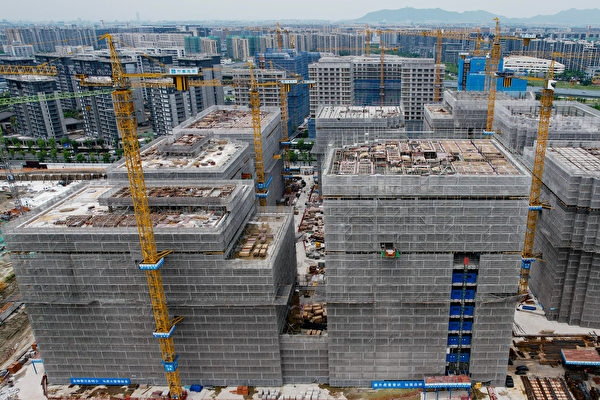Following the announcement of a round of measures to boost the economy in late September, the National Development and Reform Commission of the Chinese Communist Party (NDRC) today announced plans to introduce a package of incremental policies to address the downward pressure on the economy. However, the lack of specific measures has raised questions and doubts among observers. The stock markets in Mainland China and Hong Kong did not perform as expected after the “Golden Week” holiday, with significant fluctuations and a sharp drop in Hong Kong stocks.
The official response to queries from foreign journalists regarding the scale of the planned package of policies was vague, indicating a potential lack of further strategies on the part of the Chinese government. Experts believe this signals a shortage of new measures from the Chinese Communist Party and indirectly demonstrates the limited effectiveness of previous policies.
As the “Golden Week” holiday ended on October 8, the A-share market did not show the anticipated performance, with the Shanghai Composite Index opening high at 3,674 points but dropping to 3,496 points by noon, showing a modest increase of only 4.81%.
The Hang Seng Index in Hong Kong opened and experienced a continuous decline, plunging by 2,300 points or 10.12% at one point, marking the largest drop in nearly 16 years. By noon, the decrease had moderated to 1,289.78 points or 5.58%, settling at 21,810 points.
During the stock market fluctuations, the NDRC director Zheng Zhanjie held a press conference from 10 am to around 12 pm to announce the introduction of a package of incremental policies aimed at addressing the new challenges in the current economic situation.
Zheng stated that to counter the downward pressure on the economy, efforts would be made to strengthen macroeconomic counter-cyclical adjustments comprehensively and vigorously across the board.
The so-called package of incremental policies includes five main aspects, all of which were vaguely described in official statements. These aspects involve enhancing the effectiveness of implementing macroeconomic policies, further expanding domestic demand, increasing support for enterprises, stabilizing the real estate market, and boosting the capital market. However, there were no concrete details on specific policies such as reducing the reserve requirement ratio or implementing substantial interest rate cuts.
Regarding investment, Zheng mentioned making full use of various funds this year and optimizing the issuance of ultra-long special national bonds next year to support critical construction projects. Plans were also disclosed to release next year’s central budget investment plan of 100 billion yuan by the end of this month and a list of 100 billion yuan in “dual” construction projects, among other initiatives.
Most of these details echoed previous official statements.
Zheng also emphasized three areas of increased focus, four aspects of persistence, and five areas of targeting related to the package of incremental policies. However, the lack of concrete details in the deputy director Zhao Chenxin’s responses to questions raised concerns about the effectiveness of the Chinese Communist Party’s “strengthening” efforts, raising doubts about establishing confidence in the policy measures.
In response to the performance of the NDRC press conference, there seemed to be restricted comments on Weibo, with some media providing selected comments. Criticism abounded on overseas social media platforms, with netizens mockingly pointing out the lack of substantial content in the announced policies and the bureaucratic nature of the proceedings.
In summary, the Chinese authorities have yet to come up with groundbreaking measures beyond market expectations. Despite announcing further details on fiscal policies and efforts to boost investment and domestic demand, these measures appear to reinforce existing policies rather than introduce new strategies. The lukewarm market response indicates that these measures have not fully allayed investors’ concerns about the long-term growth prospects of the economy.
On September 24, the Chinese Communist Party officially announced a series of significant measures aimed at revitalizing the sluggish economy, including lowering the bank reserve requirement ratio, reducing mortgage rates, and down payment ratios for home purchases. Subsequently, both the Hong Kong and A-share stock markets experienced an upward trend.
Observers believe that the statement made by Zheng Zhanjie emphasizes the need to intensify efforts in response to the downward pressure on the economy, indirectly acknowledging the limited impact of previous policies in addressing the economic downturn.
Intriguingly, a Reuters journalist questioned during the press conference whether there was an estimated scale for the package of policies and inquired about the targets to be achieved. The query also touched upon the feasibility of reaching the approximately 5% economic growth target for the year. Zhao Chenxin’s response focused on reiterating previous key points without providing specific details, expressing confidence in accomplishing this year’s objectives.
Commentator Li Linyi highlighted the exchanges between foreign media questions and official responses as indicating that the Chinese Communist Party essentially admitted to running out of substantial strategies, as the terms “increased focus” and “persistence” were seen as vacuous bureaucratic rhetoric.
In conclusion, the releases during the NDRC press conference accounted for a total of 200 billion in incremental measures. The early issuance of next year’s 100 billion central budget investment plan and the 100 billion dual construction project list were disclosed as part of these measures. Nevertheless, these actions seemed to fall short of market expectations that were anticipating a significant financial injection, potentially contributing to the lukewarm opening of the A-share market today.

